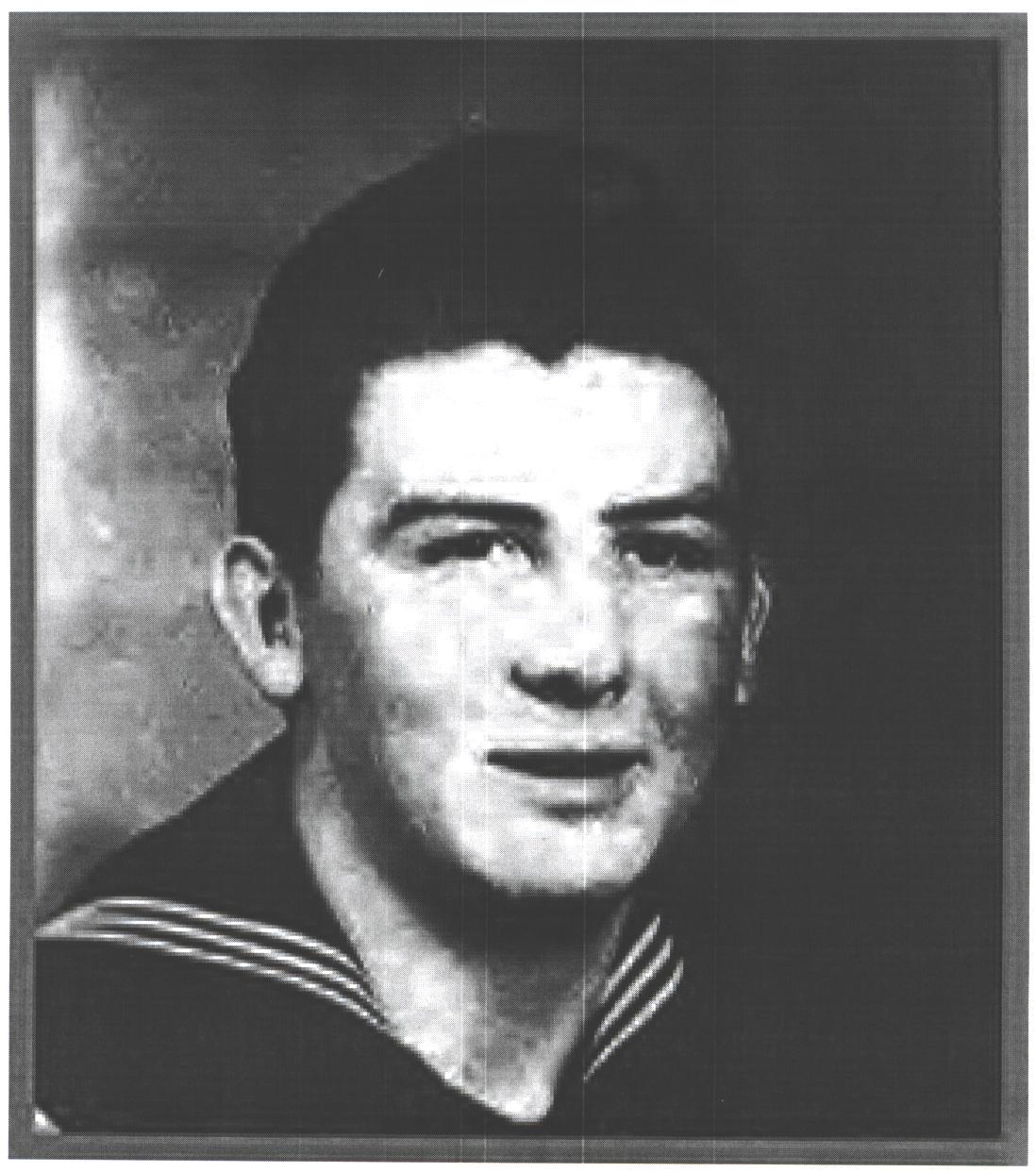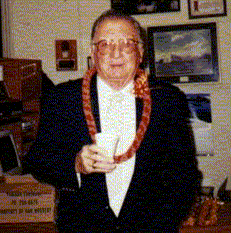Donald Gay Stratton US Navy USS Arizona |
I was born on a farm outside of Inavale, Nebraska on 14 July 1922. After going through the school system at Red Cloud, Nebraska and graduating in 1940, and being voted "The best all around athlete of that year", I joined the US Navy in October 1940. I was sent to Great Lakes Naval Training Center for boot-camp. After training, I was sent home for a week and then back to Great Lakes and from there, by train to Bremerton, Washington to board the USS Arizona BB39. The Arizona was dock-side, being worked on by ship-yard workers with electric cords laying all over the decks, welding cable likewise, air-hoses and all the equipment it has to have to get repairs of all kinds done. We stood a lot of fire watch on board as welders and yard workers were working 24 hours a day. |
Information provided by Donald Gay Stratton |

December 7, 1941 was a Sunday morning like any other, or so we thought. We were up and around and having breakfast. I had finished eating and picked up a few extra oranges in my white hat to take to a buddy in sick-bay, where my incinerator partner had gone the day before, (touch of jaundice). His name was Harl Nelson from Rouston, Arkansas. He did not survive. I went to my locker for something (in the bakery passage-way), between No. 1 and No. 2 casemates. I came out on deck via No. 2 casement to the forecastle deck and some sailors on the bow of the Arizona were shouting and pointing to some planes that were bombing Ford Island. I looked and saw the bomb blasts and thought I saw the water tower on Ford Island topple over. For some reason we recognized the planes right away as Japanese. I started immediately for my battle station, which was sight setter in the Port AA director. Seems as though everyone had seen this on deck and manned battle stations. Of course, General Quarters sounded, THIS IS NO DRILL - MAN YOUR BATTLE STATIONS! We were being strafted, torpdoed, dive bombed and hit by high-altitude bombers. There was ready box ammunition behind every AA gun, which we started firing immediately at dive bombers and later at the high-altitude bombers, which our shells never reached, as we could see the bursts very short of targets. Running short on ammunition, an Ensign Lomax (our Director Officer) went to see if he could speed up ammunition supply, never saw him again. He did not survive. About that time, the ship was hit with something that shook the ship very badly, could have been a 2000 lb. bomb that hit the starboard-side right aft of the No. 2 turret, or could have been a torpedo, as I saw, from my vantage point two torpedo wakes headed right for the Arizona. Only the good Lord knows where they wound up. Then the horrendous explosion that blew about 110 feet of the bow off, with a fire ball that went 400 - 500 feet in the air, which engulfed the whole forward half of the ship. The explosion, along with the bomb, was caused by ammunition powder, aviation gasoline (180,000 gallons), and of course fuel oil. What an awful horrendous day this was watching sailors and marines fight for this wonderful country for their very lives, (which so many perished). Some below decks did not know who or what hit them. The worst tragedy is, of course, the young American lives, but did we learn anything? Let us keep America Alert, for they say history has a way of repeating itself. I guess being inside the director saved some of our lives on the sky-control platform, as I recall it took 40 - 50 men to man both port and starboard sides of sky control, 10 men to each director, plus all the observation personnel and plane spotters. I do not know what happened to most of them as only 6 of us went across a line to the USS Vestal. The USS Vestal was tied up outboard of us, as they were doing some work on the Arizona. We could not go down the ladders as everything was burning. As the flames died down, we were out on the platform with no where to go. There was a sailor, (Joe George - found out later) out on the after deck of the Vestal who threw us a heaving line and attached a heavier line, which we pulled across to the Arizona and tied to the sky-control platform, and we, proceeded to go across the line, hand over hand, after we were burned very badly. The line was about 45 feet in the air, over lots of fire and water. Six of us went across that line and only three alive today, Lauren Bruner, Russell Lott, and myself. I was burned over 50 to 60% of my body. After we were aboard the Vestal for awhile, we were put on a motor launch and taken to the landing where we were loaded on an open air truck and driven to the US Naval Hospital in Pearl Harbor. I was there a for a few days and they decided to send some of us back to the mainland, where of course, I wanted to go. They didn't know if I would make it or not, so they decided if I could get up and stand by the side of my bed while they changed the linens, that I could go. I did, but when I laid back down I did not get up for a very long time. I arrived via USS Scott to Mare Island Naval Hospital on Christmas Day, 25 December 1941. Needless to say I have a soft spot in my heart for all the doctors, nurses and corpsman of the Navy. After several months and a lot of salt water baths and a lot of healing, I was transferred to Corona, California for a convalesence period. Then I was medically discharged as my left arm and leg were not too good yet. I was medically discharged in September 1942. I went back to Red Cloud, Nebraska where I did different jobs and proceeded to go back in the Navy, but with the help of my draft board. I was held up in Omaha, Nebraska for a few days while they got clearance from the Navy. I got my same service number, which helped a lot in the years to come. I had to go to boot camp again in Farragut, Idaho as Recruit CPO. I could have stayed there, but wanted to go to sea. I was sent to Treasure Island where I went aboard USS Stack (DD406) which proceeded to the South Seas. This was all in 1944. We were in all the invasions through New Guinea, Hallamahara, Leyte, Luzon and Okinawa. I was transferred to electric-hydraulic school in San Diego, California. Then sent to St. Louis, Missouri and discharged the second time as a GM2/c on 4 December 1945. I returned to Red Cloud, Nebraska where I met and married Velma Lockhart in 1950. To our household we added our oldest son Robert of Santa Barbara, CA who is a Vietnam vet. Then Gypsy Dawn, who only survived 3 days, then Randy of Colorado Springs, CO and then Roxanne Jo who only survived 5 days. I guess the good Lord has his own way of doing things, for we now have four wonderful granddaughters and one grandson and two great-grandsons. Two granddaughters are being highly recruited by major colleges to play basketball, the grandson was signed 13th overall and 1st round draft pick by the New York Mets, 1966. I went to work on offshore drilling barges as an Able-seaman and as a barge-master. Later went to work with deep-sea divers as a diver-tender. I worked all over the world, Alaska, Columbia, Chile, Kiwait, Nicaraugua, as well as the USA. I did a lot of pipe-line work as well as erecting offshore drilling platforms. I made a dive in a two-man submarine well over 1100 feet. I retired and moved to Yuma, Arizona in 1986 where we live today. |


Mr. Stratton's Battle Station (See the on the picture above ) |
